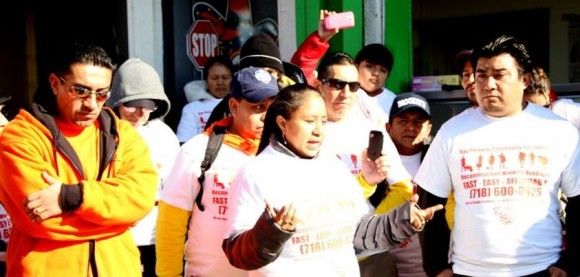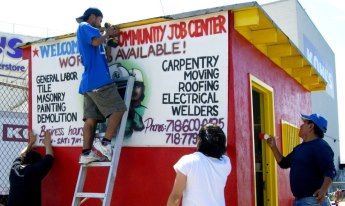Sandy Destroys Bensonhurst’s Day Laborers Center, Laborers Scramble To Rebuild

For more than 12 years, a center in Bensonhurst provided a myriad of services for day laborers and undocumented workers. The laborers depended on the center to keep them off the streets and help connect them to employers. Officials depended on the center because it helped to ensure the safety of the laborers and employers.
When Hurricane Sandy destroyed the space, it forced everyone to start from scratch.
The small red and yellow structure used to stand in the Caesar’s Bay parking lot. In the beginning, it was just a simple tent. After Caesar’s Bay management and the Department of Transportation planned to remodel the lot, Workers’ Justice Project (Proyecto Justicia Laboral) Director Ligia Guallpa asked to have a small, heated structure built. It wasn’t an easy road to convince community members to support the center, but she wouldn’t let up.
The center eventually got the backing of several local stakeholders including Councilman Vincent Gentile, Councilman Dominic Recchia, Community Board 11 and law enforcement officials at the 62nd Precinct.

Laborers came down and built the center themselves. They helped paint it too. When the Workers Justice Project Bay Parkway Community Job Center was completed, the Hispanic-American community of Bensonhurst had hope that this was a space that would stabilize and secure their futures.
“The center provided a more organized hiring site for workers. It prevented exploitation and guaranteed a professional interaction between workers and small business owners or home owners,” said Guallpa.
After massive gusts of wind and water surges relocated the center dozens of feet away from its previous location and rendered, Guallpa and the laborers knew they had a problem ahead of them. The center would be too costly for them to rebuild and in the meantime, the laborers would have nowhere to go. They didn’t want to return to waiting on the street corners, they didn’t want employers to hire them without ensuring safe work conditions, water to drink or without even guaranteeing a wage.
“It was always a chance we would go home empty handed or we would work hard and get a very low payment. A place, almost like a union, is of course better,” said Martin M., a resident of Coney Island and day laborer who says that he has, on several occasions, used the center’s services.
After the storm, the parking lot was blocked off with police tape. Neither potential employer or employee knew where to go.
“There was a great sense of insecurity. Employers were desperate, they needed help to clean up. And the laborers didn’t know if they would they ever be allowed to go back to the center. They didn’t want to go back to the corners,” said Guallpa.
Some did go back to their old haunts near 18th Avenue and waited along the sidewalk. Others went as close to the Caesar’s Bay parking lot as possible and stood there hoping for work.
Since the waterfront property is not a residential property and it isn’t near any homes, the repair work there doesn’t seem to be a priority for the city.
This, however, hasn’t stopped the workers from taking matters into their own hands. WJP has held several emergency meetings to discuss rebuilding the center. They also hosted a two day Occupational Safety and Health Administration (OSHA) training session to teach laborers about safe work conditions during hurricane clean-up since the dangers surrounding hurricane cleanup include toxic mold and rotten floorboards.
Now, WJP and their members are in the process of organizing a fundraiser. Guallpa says they need about $15,000 to rebuild. Either that, or they hope for a trailer.
“I can’t donate money,” said Martin. “But, I can give my work. I can paint or clean, it doesn’t matter.”
As part of their fundraising plans, the group wants to offer labor assistance to an employer as a raffle prize. They want to engage community investors. They want to put on a concert to raise money.
Guallpa is open to anything that will help rebuild the center. Her determination is what got the center built in the first place and it’s what she hopes will save it now.
“We have to come together. We want the community to know that we are still here,” she said.
Unfortunately, she finds herself a bit overwhelmed with the demand Sandy has placed on her. Besides the center, there are other grave issues that came up.
Unlike most people who can apply for FEMA resources to repair homes or businesses, day laborers don’t have the appropriate documentation to do so. According to Guallpa, the community is choked by fear when it comes to asking officials for assistance. Besides the loss of jobs breadwinners face, large families that occupied basement apartments in Zone A or operated stores in the area lost everything, and they won’t get any governmental help.
In order to deal with the varying crises, the WJP has been borrowing space in the Community Board 11 office and at the Brooklyn Hispanic Chamber of Commerce. Until the center is rebuilt, they refuse to demolish the last remaining bits of it.
“The center is their history and it still stands. We will still use it as is. The laborers won’t demolish it until another dignified center is built in its place,” concluded Guallpa.




